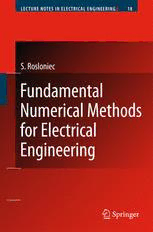Table Of ContentLecture Notes Electrical Engineering
Volume 18
Stanisław Rosłoniec
Fundamental Numerical Methods
for Electrical Engineering
123
Prof.Dr.Hab.Ing.StanisławRosłoniec
InstituteofRadioelectronics
WarsawUniversityofTechnology
Nowowiejska15/19
00-665Warsaw
Poland
[email protected]
ISBN:978-3-540-79518-6 e-ISBN:978-3-540-79519-3
LibraryofCongressControlNumber:2008927874
(cid:2)c 2008Springer-VerlagBerlinHeidelberg
Thisworkissubjecttocopyright.Allrightsarereserved,whetherthewholeorpartofthematerialis
concerned,specificallytherightsoftranslation,reprinting,reuseofillustrations,recitation,broadcasting,
reproductiononmicrofilmorinanyotherway,andstorageindatabanks.Duplicationofthispublication
orpartsthereofispermittedonlyundertheprovisionsoftheGermanCopyrightLawofSeptember9,
1965,initscurrentversion,andpermissionforusemustalwaysbeobtainedfromSpringer.Violationsare
liabletoprosecutionundertheGermanCopyrightLaw.
Theuseofgeneraldescriptivenames,registerednames,trademarks,etc.inthispublicationdoesnotimply,
evenintheabsenceofaspecificstatement,thatsuchnamesareexemptfromtherelevantprotectivelaws
andregulationsandthereforefreeforgeneraluse.
Coverdesign:eStudioCalamarS.L.
Printedonacid-freepaper
9 8 7 6 5 4 3 2 1
springer.com
Contents
Introduction ....................................................... xi
1 MethodsforNumericalSolutionofLinearEquations................ 1
1.1 DirectMethods.............................................. 5
1.1.1 TheGaussEliminationMethod.......................... 5
1.1.2 TheGauss–JordanEliminationMethod................... 9
1.1.3 TheLUMatrixDecompositionMethod................... 11
1.1.4 TheMethodofInverseMatrix........................... 14
1.2 IndirectorIterativeMethods .................................. 17
1.2.1 TheDirectIterationMethod ............................ 17
1.2.2 JacobiandGauss–SeidelMethods ....................... 18
1.3 ExamplesofApplicationsinElectricalEngineering ............... 23
References ...................................................... 27
2 MethodsforNumericalSolvingtheSingleNonlinearEquations ...... 29
2.1 DeterminationoftheComplexRootsofPolynomialEquations
byUsingtheLin’sandBairstow’sMethods...................... 30
2.1.1 Lin’sMethod......................................... 30
2.1.2 Bairstow’sMethod .................................... 32
2.1.3 LaguerreMethod ..................................... 35
2.2 IterativeMethodsUsedforSolvingTranscendentalEquations ...... 36
2.2.1 BisectionMethodofBolzano ........................... 37
2.2.2 TheSecantMethod.................................... 38
2.2.3 MethodofTangents(Newton–Raphson) .................. 40
2.3 OptimizationMethods........................................ 42
2.4 ExamplesofApplications..................................... 44
References ...................................................... 47
3 MethodsforNumericalSolutionofNonlinearEquations............. 49
3.1 TheMethodofDirectIterations................................ 49
3.2 TheIterativeParameterPerturbationProcedure................... 51
3.3 TheNewtonIterativeMethod.................................. 52
v
vi Contents
3.4 TheEquivalentOptimizationStrategies ......................... 56
3.5 ExamplesofApplicationsintheMicrowaveTechnique ............ 58
References ...................................................... 68
4 Methods for the Interpolation and Approximation of One
VariableFunction ............................................... 69
4.1 FundamentalInterpolationMethods ............................ 72
4.1.1 ThePiecewiseLinearInterpolation ...................... 72
4.1.2 TheLagrangeInterpolatingPolynomial................... 73
4.1.3 TheAitkenInterpolationMethod ........................ 76
4.1.4 TheNewton–GregoryInterpolatingPolynomial............ 77
4.1.5 InterpolationbyCubicSplineFunctions .................. 82
4.1.6 Interpolation by a Linear Combination of Chebyshev
PolynomialsoftheFirstKind .......................... 86
4.2 FundamentalApproximationMethodsforOneVariableFunctions... 89
4.2.1 TheEqualRipple(Chebyshev)Approximation ............ 89
4.2.2 TheMaximallyFlat(Butterworth)Approximation.......... 94
4.2.3 Approximation(CurveFitting)bytheMethodofLeastSquares 97
4.2.4 ApproximationofPeriodicalFunctionsbyFourierSeries....102
4.3 Examples of the Application of Chebyshev Polynomials
in Synthesis of Radiation Patterns of the In-Phase Linear
ArrayAntenna.............................................. 111
References ......................................................120
5 MethodsforNumericalIntegrationofOneandTwo
VariableFunctions ...............................................121
5.1 Integration of Definite Integrals by Expanding the Integrand
FunctioninFiniteSeriesofAnalyticallyIntegrableFunctions ...... 123
5.2 Fundamental Methods for Numerical Integration
ofOneVariableFunctions .................................... 125
5.2.1 RectangularandTrapezoidalMethodsofIntegration........125
5.2.2 TheRombergIntegrationRule ..........................130
5.2.3 TheSimpsonMethodofIntegration......................132
5.2.4 TheNewton–CotesMethodofIntegration.................136
5.2.5 TheCubicSplineFunctionQuadrature ...................138
5.2.6 TheGaussandChebyshevQuadratures...................140
5.3 MethodsforNumericalIntegrationofTwoVariableFunctions ......147
5.3.1 TheMethodofSmall(Elementary)Cells .................147
5.3.2 TheSimpsonCubatureFormula .........................148
5.4 AnExampleofApplications ..................................151
References ......................................................154
6 NumericalDifferentiationofOne
andTwoVariableFunctions ......................................155
6.1 ApproximatingtheDerivativesofOneVariableFunctions..........157
Contents vii
6.2 Calculating the Derivatives of One Variable Function
byDifferentiationoftheCorrespondingInterpolatingPolynomial ... 163
6.2.1 Differentiation of the Newton–Gregory Polynomial
andCubicSplineFunctions ............................ 163
6.3 Formulas for Numerical Differentiation of Two
VariableFunctions .......................................... 168
6.4 An Example of the Two-Dimensional Optimization Problem
anditsSolutionbyUsingtheGradientMinimizationTechnique .... 172
References ......................................................177
7 MethodsforNumericalIntegrationofOrdinary
DifferentialEquations ...........................................179
7.1 TheInitialValueProblemandRelatedSolutionMethods...........179
7.2 TheOne-StepMethods .......................................180
7.2.1 TheEulerMethodanditsModifiedVersion ...............180
7.2.2 TheHeunMethod.....................................182
7.2.3 TheRunge–KuttaMethod(RK4)........................184
7.2.4 TheRunge–Kutta–FehlbergMethod(RKF45).............186
7.3 TheMulti-stepPredictor–CorrectorMethods.....................189
7.3.1 TheAdams–Bashforth–MoulthonMethod ................193
7.3.2 TheMilne–SimpsonMethod............................194
7.3.3 TheHammingMethod.................................197
7.4 Examples of Using the RK 4 Method for Integration
ofDifferentialEquationsFormulatedforSomeElectricalRectifier
Devices.................................................... 199
7.4.1 TheUnsymmetricalVoltageDoubler.....................199
7.4.2 TheFull-WaveRectifierIntegratedwiththeThree-Element
Low-PassFilter ...................................... 204
7.4.3 TheQuadrupleSymmetricalVoltageMultiplier ............208
7.5 An Example of Solution of Riccati Equation Formulated
foraNonhomogenousTransmissionLineSegment ............... 215
7.6 An Example of Application of the Finite Difference Method
forSolvingtheLinearBoundaryValueProblem.................. 219
References ......................................................221
8 The Finite Difference Method Adopted for Solving Laplace
BoundaryValueProblems........................................223
8.1 TheInteriorandExternalLaplaceBoundaryValueProblems .......226
8.2 TheAlgorithmforNumericalSolvingofTwo-DimensionalLaplace
BoundaryProblemsbyUsingtheFiniteDifferenceMethod ........ 228
8.2.1 TheLiebmannComputationalProcedure..................231
8.2.2 TheSuccessiveOver-RelaxationMethod(SOR) ...........238
8.3 Difference Formulas for Numerical Calculation
of a Normal Component of an Electric Field Vector
atGoodConductingPlanes ................................... 242
viii Contents
8.4 Examples of Computation of the Characteristic Impedance
andAttenuationCoefficientforSomeTEMTransmissionLines..... 245
8.4.1 TheShieldedTriplateStripline ..........................246
8.4.2 TheSquareCoaxialLine ...............................249
8.4.3 TheTriplateStripline ..................................251
8.4.4 TheShieldedInvertedMicrostripLine....................253
8.4.5 TheShieldedSlabLine ................................258
8.4.6 ShieldedEdgeCoupledTriplateStriplines ................263
References ......................................................268
A EquationofaPlaneinThree-DimensionalSpace....................269
B TheInverseoftheGivenNonsingularSquareMatrix................271
C TheFastEliminationMethod.....................................273
D The Doolittle Formulas Making Possible Presentation of a
Nonsingular Square Matrix in the form of the Product of Two
TriangularMatrices .............................................275
E Difference Formula for Calculation of the Electric Potential at
PointsLyingontheBorderBetweentwoLooselessDielectricMedia
WithoutElectricalCharges.......................................277
F CompleteEllipticIntegralsoftheFirstKind .......................279
SubjectIndex ......................................................281
About the Author
Stanisław Rosłoniec received his M.Sc. degree in electronic engineering from the
Warsaw University of Technology, Warsaw, in 1972. After graduation he joined
the Department of Electronics, (Institute of Radioelectronics), Warsaw University
of Technology where in 1976 he was granted with distinction his doctor’s degree
(Ph.D). The thesis has been devoted to nonlinear phenomena occurring in mi-
crowaveoscillatorswithavalancheandGunndiodes.In1991,hereceivedDoctorate
inSciencedegreeinelectronicengineeringfromtheWarsawUniversityofTechnol-
ogyforahabilitationthesisonnewmethodsofdesigninglinearmicrowavecircuits.
Finally, he received in 2001 the degree of professor of technical science. In 1996,
he was appointed as associate professor in the Warsaw University of Technology,
where he lectured on “Fundamentals of radar and radionavigation techniques”,
“UHFandmicrowaveantennas”,“Numericalmethods”and“Methodsforanalysis
ix
x AbouttheAuthor
and synthesisofmicrowavecircuits”.Hismainresearchinterestiscomputer-aided
design of different microwave circuits, and especially planar multi-element array
antennas. He is the author of more than 80 scientific papers, 30 technical reports
and6books,viz.“Algorithmsfordesignofselectedlinearmicrowavecircuits”(in
Polish),WkŁ,Warsaw1987, “Mathematical methods fordesigning electronic cir-
cuitswithdistributedparameters”(inPolish),WNT,Warsaw1988,“Algorithmsfor
computer-aided design of linear microwave circuits”, Artech House, Inc. Boston–
London 1990, “Linear microwave circuits – methods for analysis and synthesis”
(inPolish),WKŁ,Warsaw1999and“Fundamentalsoftheantennatechnique”(in
Polish),PublishingHouseoftheWarsawUniversityofTechnology,Warsaw2006.
The last of them is the present book “Fundamental Numerical Methods for Elec-
tricalEngineering”.Since1992,Prof.Rosloniechasbeentightlycooperatingwith
theTelecommunicationsResearchInstitute(PIT)inWarsaw.Themainsubjectofhis
professionalactivityinPITisdesigningtheplanar,in-phasearrayantennasintended
for operation in long-range three-dimensional (3D) surveillance radar stations. A
fewoftwo-dimensional(planar)arrayantennasdesignedbyhimoperateinradars
of type TRD-12, RST-12M, CAR 1100 and TRS-15. These modern radar stations
havebeenfabricatedbyPITforthePolishArmyandforeigncontractors.
Introduction
Stormy development of electronic computation techniques (computer systems and
software),observedduringthelastdecades,hasmadepossibleautomationofdata
processing in many important human activity areas, such as science, technology,
economics and labor organization. In a broadly understood technology area, this
developmentledtoseparationofspecializedformsofusingcomputersforthedesign
andmanufacturingprocesses,thatis:
– computer-aideddesign(CAD)
– computer-aidedmanufacture(CAM)
In order to show the role of computer in the first of the two applications men-
tionedabove,letusconsiderbasicstagesofthedesignprocessforastandardpiece
ofelectronicsystem,orequipment:
– formulationofrequirementsconcerninguserproperties(characteristics,parame-
ters)ofthedesignedequipment,
– elaborationoftheinitial,possiblygeneralelectricstructure,
– determinationofmathematicalmodelofthesystemonthebasisoftheadopted
electricstructure,
– determinationofbasicresponses(frequency-ortime-domain)ofthesystem,on
thebaseofpreviouslyestablishedmathematicalmodel,
– repeatedmodificationoftheadopteddiagram(changingitsstructureorelement
values)incase,whenitdoesnotsatisfytheadoptedrequirements,
– preparationofdesignandtechnologicaldocumentation,
– manufacturingofmodel(prototype)series,accordingtotheprepareddocumen-
tation,
– testingtheprototypeundertheaspectofitselectricproperties,mechanicaldura-
bilityandsensitivitytoenvironmentconditions,
– modification of prototype documentation, if necessary, and handing over the
documentationtoseriesproduction.
The most important stages of the process under discussion are illustrated in
Fig.I.1.
xi

